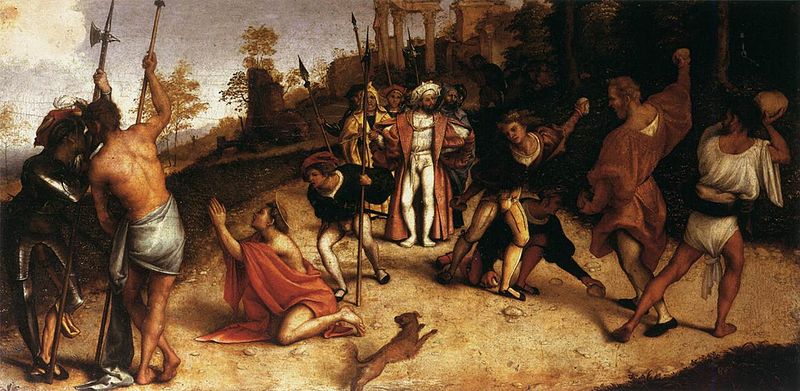[Greek] γονυπετέω (gonupeteō), [Latin] genuflectere: to kneel, to fall on the knees, to kneel down, to give homage, to bow the knee; Mk.15:19, Lk.22:41, Mt.26:39, Mk.14:35, Acts 7:60, Acts 9:40, Acts 20:36, Acts 21:5, Mt.17:14, Mt.27:29, Mk.1:40, Mk.10:17

The Martyrdom of St. Stephen: painting by Lorenzo Lotto (1513)
Background information:
Greek Hellenism: This term means to kneel, to kneel down, to fall on the knee or to fall down before one. There is generally no distinction between genuflection and full prostration. The recipients of such devotion include slaveholders, illustrious citizens, and the gods. It was a customary practice for a slave to kneel down before his master. There was genuflection before the gods (and other deities) in prayer. Sometimes, in the normal worship of the official gods there was no bowing of the knee.
Polybius’ Histories 15.29 states “But his mother Oenanthe went in great distress to the temple of Demeter and Persephone, and there first of all she besought the aid of the goddesses with bending of the knee and strange incantations.” Euripides’ Phoenissae 293 states “I fall to my knees before you, lord, honoring the custom of my home.” Herodotus’ Histories 7.136 states “From there they came to Susa, into the king’s presence, and when the guards commanded and would have compelled them to fall down and bow to the king, they said they would never do that.”
Old Testament: The gesture of genuflection indicates a sign of humility and worship in the prayer of the individual or the community to God. Genuflection can reflect a sign of abasement, acknowledgement, and homage before God. Bowing down may also involve outstretched hands reaching towards heaven. Sometimes genuflection or devotion is given to the gods. The expression ‘every knee’ represents a person.
Solomon rose from before the altar of the Lord, where he had been kneeling with his hands outstretched toward heaven (1Kgs.8:54). Yet I will leave seven thousand men is Israel: all those who have not knelt to Baal or kissed him (1Kgs.19:18). When the third captain arrived, he fell to his knees before Elijah, pleading with him (4Kgs.1:13). And the whole assembly blessed the Lord, bowing down and prostrating themselves before the Lord (1Chr.29:20). To Me every knew shall bend (Isa.45:23). Daniel continued his custom of going home to kneel in prayer and give thanks to his God (Dan.6:10).
New Testament: This term can mean kneeling down or kneeling down in prayer. The welcoming father kneels down in joyfulness upon his son’s return to him. The Roman soldiers mockingly “kneel down” at Jesus on His way to His crucifixion. In many situations, one kneels down and prays to God. Like Jesus, Stephen kneels down and prays that God will forgive those who will kill him. Others comes to kneel down before Jesus in hopes of being healed or cured.
Scripture:
“And kept striking His head with a reed and spitting upon Him. They knelt before Him in homage.” Mk.15:19
The Roman soldiers mocked Jesus after placing a purple cloth and thorns on Him.
“A leper came to Him and kneeling down begged Him and said, ‘If you wish, you can make me clean.’”Mk.1:40
Jesus healed the leper. Moved with pity, Jesus healed him. Jesus instructs to report to the priests
“Then Stephen fell to his knees and cried out in a loud voice, ‘Lord, do not hold this sin against them’, and when he said this, he fell asleep.” Acts 7:60
Stephen called upon to forgive those who killed him. Stephen was praying when he was kneeling down.
Genuflection: This term comes from the Latin genu (knee) and the Latin flectere (to bend). From today’s perspective, the notion of genuflecting may sound like a old fashioned or quaint practice. In first century Rome, it was expected that one would get down on bended knee when the emperor or statue of a god passes by. This action was considered as a sign of reverence. You were showing that the emperor or statue was divine. However, many early Christians viewed genuflection as form of polytheistic practice. But the meaning of genuflection changed over time into a sign of respect for those in authority. In later years subjects would genuflect before their king. Kings would genuflect before the pope. Christians adapted this practice for popes, cardinals, and bishops. But over time people began genuflecting before holy objects. Interestingly, the meaning of genuflection again changed over time to its original meaning as a means to show veneration and adoration for God alone. Catholics now genuflect before the blessed sacrament (Eucharist) at Mass and in the tabernacle.
Conclusion:
Genuflect, genuflection
In the Greek Hellenistic era, it was customary, although unsettling, to learn that slaves knelt down before their masters. Subjects (people) often knelt down before their kings (and queens). It was also customary to kneel down before the gods, yet standing was permitted regarding the official gods.
In the monotheistic Old Testament culture, it was quite common for the priest (and others) to kneel down (and extend one’s arms toward heaven) in the Lord’s presence. However, it was a severe religious sacrilege to kneel down and kiss idols and gods. It is noteworthy to acknowledge that there existed a practice of kissing venerated or sacrilegious objects.
In the New Testament, kneeling down can be found in non-religious contexts (welcoming and mocking). Scripture shows a consistent pattern of praying following kneeling down. Such examples include Jesus, Paul, and Peter. Those who seek healing come to and kneel down before Jesus.
Catholic liturgy: On Good Friday, many Catholics venerate (kneel down before or kiss) the empty Cross. Catholics, upon entering the Tabernacle (the room storing the Eucharist), generally genuflect (kneel down) before Jesus’ presence upon entering this room. Jesus is both King and God.
Taking a knee can be a form of reflection, ending a play, a break, silence, prayer, or even protest.
It’s time to end this post, so I am taking a knee.
